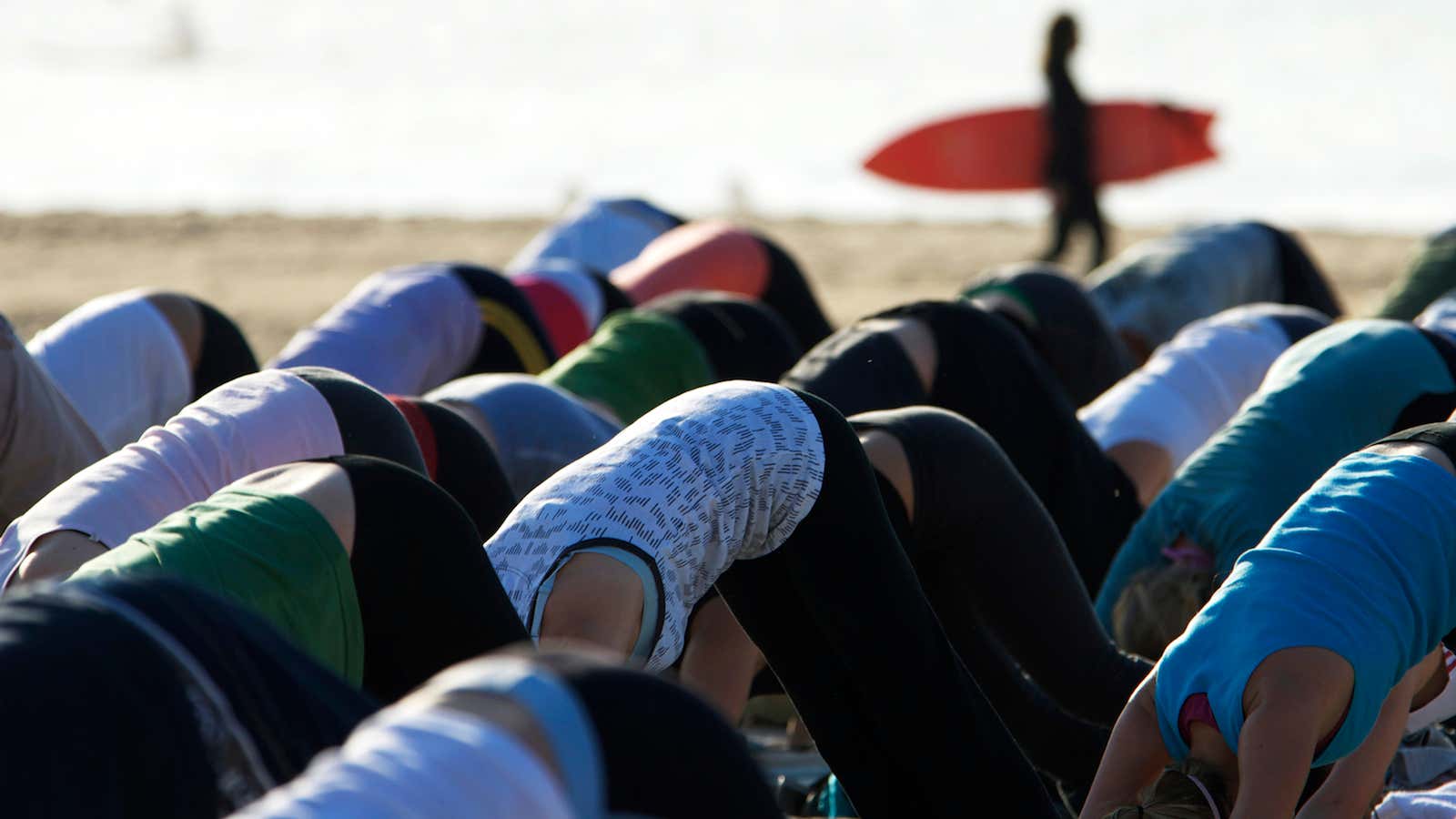In New York or L.A., it’s pretty common to learn that a yoga teacher used to be a dancer, an actor, or even a former Wall Street banker. In Bogota and Medellin, the same is true. Except that here, the teacher may also be an ex-member of a Colombian death squad.
Since 2010, a local organization called Dunna: Alternativas Creativas Para la Paz (Dunna: Creative Alternatives for Peace) has been gradually introducing the basic poses to two groups for whom yoga has been a foreign concept: the poor, mostly rural victims of Colombia’s brutal, half-century conflict, and the guerilla fighters who once terrorized them.
Hundreds of ex-militants have already taken the offered yoga courses. A dozen now plan to teach yoga to others.
The yoga students
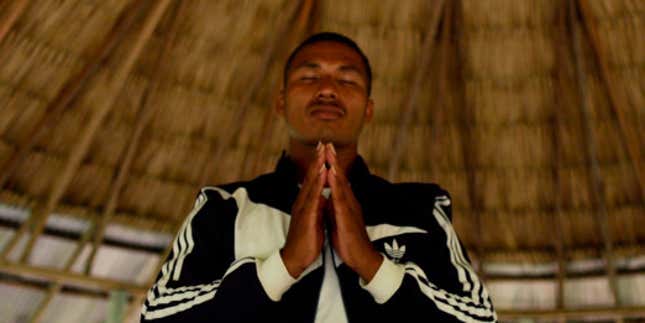
To stay calm, yoga-teacher-in-training Edifrando Valderrama Holguin turns off the television whenever he sees news broadcasts about young people being recruited into terror groups like ISIL. Valderrama was 12 when he was recruited into the Revolutionary Armed Forces of Colombia (FARC). He was given a gun, basic training and a heavy dose of leftist ideology. “In the mountains, if I saw someone who was not part of our group, I had to kill him,” he says. “If I had questioned the ideology of the FARC, they would have called me an infiltrator and killed me.”
Now 28, Valderrama lives in the city of Medellin. He works afternoon shifts for a supplier to one of Colombia’s major meat companies, and practices yoga at home in the mornings. Until the program stopped last year, he attended Dunna’s yoga classes, rolling out his mat with former members of both the FARC and Autodefensas Unidas de Colombia (AUC)—a paramilitary army he once fought against. Although initially surprised that he could feel so much peace lying in corpse pose, Valderrama now hopes to become a yoga teacher, so that he can introduce the healing asanas to ex-militants in Colombia, or even overseas.
Samuel Urueña Lievano, 46, was raped and then recruited into the rival AUC by a relative when he was 15. “They used my anger and hatred to get me to join. I have so much remorse for the things I did during that period,” he tells me as he begins to cry.
Urueña, now a law student in Bogota, takes medications to manage his anxiety and still has nightmares. He calls yoga his closest friend. Practicing the poses every day for two hours has made it possible for him to handle occasional feelings of panic, impatience and frustration, he says. “It has helped me identify who I am. It has given me myself back.
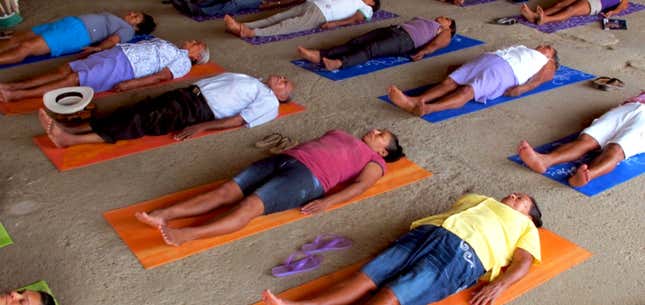
Colombia’s bloody history
Ten years ago, the suggestion that former members of the FARC and the AUC might one day sit together in lotus position would have seemed laughable.
Fighting between these two main factions, splinter groups, crime syndicates and the Colombian army was intense and vicious until about 2006, when the conflict finally began to taper off thanks to a combination of geopolitical forces. War now lingers in only remote corners of the country. These days, the government is holding peace talks with FARC leaders, and many Colombians are optimistic that the war, which has takendisplaced more than 5.7 million people and taken more than 220,000 lives since 1948, will finally end.
Nearly 57,000 former members of the FARC, the AUC, and other combat groups have been demobilized. Of them, roughly 30,000 are enrolled in a seven-year program by the Colombian Agency for Reintegration (ACR) that offers financial subsidies, education, vocational training, and psychosocial services. Until Oct. 2014, the ACR offered Dunna’s yoga classes to demobilized combatants with post-traumatic stress disorder.
Civilian victims of the the conflict
For civilian victims of the war, Dunna runs an even larger parallel program.
Forty-one-year-old Ingrid Rosellón Montenegro heard about yoga classes through the town office for victims in tiny El Retén. In 1999, she fled her hometown of Santa Rita when it was taken over by an armed group, only to be kidnapped by another group seven years later, which left what she calls “a depression in my heart.” But yoga has helped, she says. “Even my children have noticed the difference. I’m not always so sad. I’m less tense.”
Her classmate and fellow civilian survivor, Johnny Sosa Rodríguez, 40, says he imagined yoga was “some form of combat from the Far East.” Now it means everything, he says, adding proudly, “It helped me get my family back.”
Sosa watched guerillas shoot his brother in the head nine years ago. Unable to cope with the emotions that followed, he became aggressive, forcing his wife and children to move out of the house. “I had so much anger and hatred, they decided to go away,” he explains. That has all changed. “Yoga has made me a likable human being, a productive being.”
Both Rosellón and Sosa had tried medications and talk therapy. “But I was never able to express my anger,” says Sosa. Anti-anxiety pills made Rosellón feel drugged and groggy.
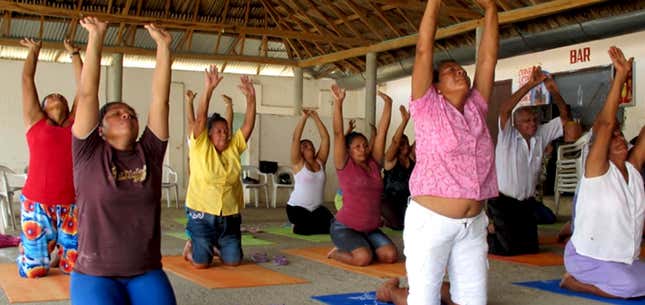
The science of yoga as trauma therapy
Dunna was co-founded in 2010 by New York University law school graduate, Natalia Quiñones, the organization’s research director, and María Adelaida López, a Colombian-born graduate of the University of London and longtime yogi, now the non-profit’s executive director. Together the two women secured backing from a handful of sources. Between 10% and 20% of Dunna’s funding comes from private foundations and corporations, says Quiñones, and public money covers the rest.
To prove that public funds have been well spent, Dunna’s researchers tracked yoga’s effectiveness in a controlled study of 45 demilitarized individuals who took one-hour classes twice weekly for four months. Results showed a 48.5% decrease in symptoms of post traumatic stress disorder (PTSD), compared to a group not in the program. When the yoga course was expanded to five more cities in Colombia, students again reported an easing of symptoms, and reduced drug and alcohol use.
Several studies have already demonstrated yoga’s ability to rebalance the nervous system and improve symptoms of PTSD in ways that traditional talk therapy can’t always do. PTSD sufferers’ brains are thought to experience past trauma as if it were still happening, causing them to be jumpy, despondent, or simply “frozen” in response to a threat that no longer exists. But if the sufferers feel safe and aware of the present, that feeling of threat recedes into the past.
For that, they may need yoga. Talking simply doesn’t change the deeper structures of the brain where trauma sits, according to psychiatrist and trauma specialist Bessel van der Kolk, who recently explained how yoga and mindfulness helps PTSD on Shrink Rap radio. Only the medial prefrontal cortex, which is devoted to self-reflection, can do that. Thus, argues Van der Kolk: “You cannot really deal with trauma unless you develop some kind of commitment to observe yourself, to notice yourself and spend time with yourself in silence.”
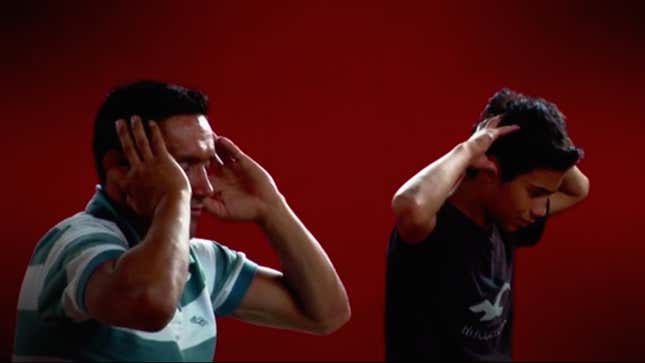
Colombia’s future yoga teachers
Joshua Mitrotti, director of the ACR, says he was impressed with the reports from Dunna’s first few years of work with demobilized fighters. However, the ACR has limited funds, and has decided to save money this year by designing its own yoga curriculum, including a yoga teacher-training course.
Former fighters will be better-suited for teaching yoga to other demobilized combatants, says Mitrotti. “Who else knows better what they’ve been through?” he asks. “Who else knows better what they’re going through now?”
FARC member, Elena Arrieta, 48, fought for twenty years and lost a son in the conflict. Last year, she became a yoga mentor with Dunna. Now she is on the list of those who would like to be certified to teach.
“I would tell people, ‘Yes, we were part of an armed group, but now we just need to let go of those things, so that we can heal and move on,’” she says. “Yoga is like freedom.”
